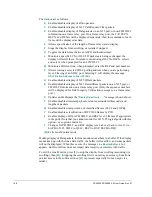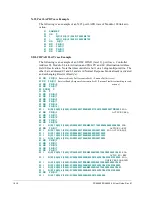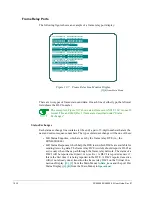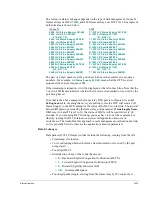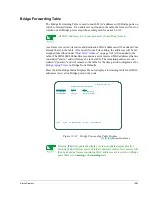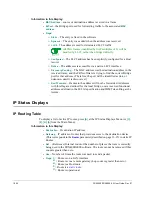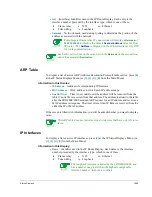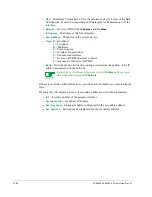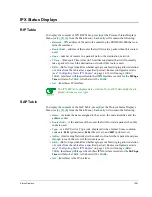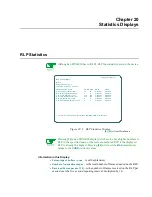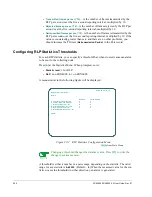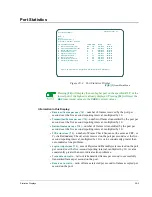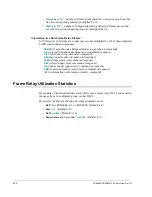
19-22
FRX4000/FRX6000 4.0 User Guide, Rev 01
If there are more Bridge ports than will fit on one screen, pressing
[PgUp]
or
[PgDn]
will display other screens.
Pressing
[F2]
at the screen in Figure 19-11 will display a screen of Bridge port statistics
for the ports on the above screen.
Bridge statistics
are described on
page 20-11
.
Information on the Bridge Port Status Display:
●
Type/Format
– identifies the interface type (Ethernet, Token Ring, or frame
relay) and (if frame relay) frame format (Native LLC2, 8025_SRB, or 8023_TB,
as configured in the Port record).
●
Status
(
Active
or
Inactive
) – is the operational state of the underlying physical
port. The status will be
Inactive
only if the port is "blocked." (See "
Blocked Port
Flag
" on page 7-16.)
●
Bridge State
– can be any of the following. (Note that a Bridge can be in an
enabled state even if the physical port is inactive):
◆
Disabled
– the Bridge port has been disabled by operator action. The port
can leave this state through an operator re-enable or node IPL.
◆
Listening
– the Bridge port is transitioning to the
Learning
state. Only
BPDU frames will be received or transmitted, to allow the port to get its
status into the spanning tree algorithm. The port will leave this state when
the
Bridge Forward Delay
timer (described on page 15-4) expires. If the port
is selected as
Root
or
Designated
port, it will enter
Forwarding
state. If the
port is not selected as
Root
or
Designated
port, it will enter
Blocking
state.
A
Root
port is the one selected by the spanning tree algorithm as
the port used to reach the root bridge (which is the least-cost
bridge in a link). A
Designated
port is the port that connects to
the least-cost path to the root bridge.
◆
Learning
– BPDUs ("Hello" messages) are being sent between bridges, and
the spanning tree algorithm is being updated. The port will leave this state
when the
Bridge Forward Delay
timer (described on page 15-4) expires. If
the port is selected as
Root
or
Designated
port, it will enter
Forwarding
state. If the port is not selected as
Root
or
Designated
port, it will enter
Blocking
state.
◆
Forwarding
– the Bridge port is participating in bridging of frames, as well
as ongoing learning and updating of the spanning tree algorithm. If the
algorithm redesignates the port as non-root or non-designated, the port
might enter
Blocking
state.
◆
Blocking
– the Bridge port has not been selected as
Root
or
Designated
, and
is transitioning to the
Listening
state.
●
Rcv/Xmit
– are the cumulative bytes received/transmitted on the Bridge port.
Содержание Netlink FRX4000
Страница 2: ......
Страница 16: ...xiv FRX4000 FRX6000 4 0 User Guide Rev 01 ...
Страница 17: ...Section I Getting Started ...
Страница 18: ......
Страница 24: ......
Страница 37: ...Section II Configuration ...
Страница 38: ......
Страница 52: ......
Страница 78: ......
Страница 106: ...7 24 FRX4000 FRX6000 4 0 User Guide Rev 01 ...
Страница 142: ...8 36 FRX4000 FRX6000 4 0 User Guide Rev 01 ...
Страница 186: ......
Страница 216: ......
Страница 266: ......
Страница 273: ...Section III Operation ...
Страница 274: ......
Страница 296: ......
Страница 324: ......
Страница 376: ......
Страница 377: ...Section IV Appendices ...
Страница 378: ......
Страница 384: ......
Страница 390: ......
Страница 396: ......
Страница 400: ......
Страница 405: ...Menu Structure E 5 ...
Страница 406: ...E 6 FRX4000 FRX6000 4 0 User Guide Rev 01 ...
Страница 425: ......
Страница 426: ......

